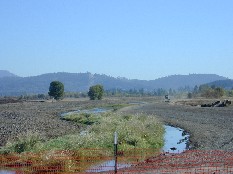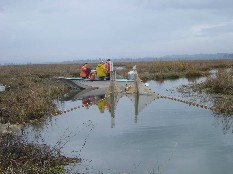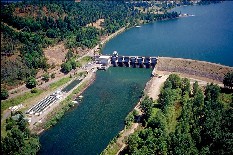Welcome to Portland District's Planning Branch. The Planning Branch studies potential water resource development projects in Oregon and parts of southwestern Washington. These studies analyze and solve water resource issues of concern to local communities. These issues may involve navigational improvements, flood damage reduction, or ecosystem restoration. Planning Branch staff have also supported the Department of the Army's efforts to rebuild the infrastructure of Iraq. To read about their experiences in the Middle East, please click here.
Planning offers a structured, rational approach to solving problems. For the U.S. Army Corps of Engineers Civil Works program, everything begins with planning. Planning is the means for addressing water resource needs. Without fruitful planning, creative, cost-effective solutions to these needs cannot be found. All projects sart with planners answering the questions: "Can we?" and "Should we?" Planners help decision makers identify water resource problems, conceive solutions to them, and compare the importance of the inevitable conflicting values inherent in any solution.
Planning is a creative process requiring experience, analysis, intuition and inspiration. The more the process is used, the better one gets at solving complex problems. Planning typically involves a very broad knowledge base and operates in a creative, dynamic manner. Planning is not a solitary pursuit; it is best done by an interdisciplinary team. Good planning involves the knowledge, skills and insights of professionals from many of the natural, social and engineering sciences.
Planning requires men and women with knowledge, imagination, and skills, and a commitment to critically examine and act on objectives concerned with the improvement of the human condition. Planners must respond to complex and interrelated processes of social, economic, cultural, environmental and political change at every scale from the local to the global. Their specialized expertise derives from their ability to relate scientific and technical knowledge to action in the public domain. No one discipline prepares a person to be a planner. Planning Branch staff come from a variety of backgrounds, posessing diverse technical expertise. We have been engineers, chemists, economists, and whitewater rafting guides. Planning is intrinsically an interdisciplinary process: we work collaboratively with other Corps technical staff, local sponsors and the public.
Planning Branch staff are engaged in projects under a number of Corps authorities, as both planners and managers. Several important categories of projects that are worked on include: Individually Authorized studies and projects, Continuing Authorities Program (CAP) projects, Planning Assistance to States (PAS) projects, Flood Plain Management Services (FPMS) projects, and Lower Columbia River Estuary Projects.
General Investigation (GI) Studies and Projects
General Investigation (GI) studies and projects, also referred to as Individually Authorized studies and projects, are the traditional and most common way for us to help a community solve a water resource problem. They involve jointly conducting a study with a sponsor and, if shown by the study to be feasible, the construction and implementation of the project. This approach requires that Congress provide us first with authorization to accomplish a feasibility study and second, a separate authorization to construct or implement the project. The project studies and construction are cost-shared between the federal government and the sponsor, who usually pays all operations and maintenance costs. This approach may be used to address a variety of water resources problems. Unlike the Continuing Authorities Program (see below), there are no project specific federal cost limitations for individually authorized studies or projects. For more information about Individually Authorized studies and projects, and those currently being pursued in the Portland District, please click here.
conducting a study with a sponsor and, if shown by the study to be feasible, the construction and implementation of the project. This approach requires that Congress provide us first with authorization to accomplish a feasibility study and second, a separate authorization to construct or implement the project. The project studies and construction are cost-shared between the federal government and the sponsor, who usually pays all operations and maintenance costs. This approach may be used to address a variety of water resources problems. Unlike the Continuing Authorities Program (see below), there are no project specific federal cost limitations for individually authorized studies or projects. For more information about Individually Authorized studies and projects, and those currently being pursued in the Portland District, please click here.
Continuing Authorities Program (CAP)
Congress has provided the Corps, under the Continuing Authorities Program (CAP), a number of standing authorities to study and build water resource development projects for various purposes with specified limits on how much federal money can be spent. These projects are cost shared between the federal government and a non-federal Sponsor. Specific congressional authorizations are not needed, saving development and approval time, and permitting quicker responses to smaller, local problems. For more information on the specific CAP authorities and the projects that are currently being pursued in the Portland District, please click here.
Planning Assistance to States (PAS)
The Planning Assistance to States (PAS) Program, also known as the Section 22 Program, permits us to use our technical planning expertise to supplement and support non-federal sponsors in developing plans for the development, use and conservation of water and related land resources. The program is cost-shared on a 50 percent federal and 50 percent non-federal basis. For more information on the PAS program and the projects that are currently being pursued in the Portland District, please click here.
Flood Plain Management Services (FPMS)
The Flood Plain Management Services program (FPMS) involves the Corps using our technical expertise in flood plain management to provide states, counties, cities, tribes, and certain federal agencies with flood hazard information, technical services, and planning guidance without charge. Program services are also offered to other federal agencies and the private sector on a 100 percent cost recovery basis. For more information on the FPMS, please click here.
Lower Columbia River Projects (LCR)
As you might expect, the Portland District is involved in many projects in the Lower Columbia River and its estuary. A number of these projects are being pursued under the programs listed above. Additionally, several projects are being pursued under the Section 536 program, which provides for ecosystem restoration projects specifically in the Lower Columbia River Estuary and Tillamook Bay. For more information about the Section 536 program, as well as the other projects being pursued in the Lower Columbia River Estuary, please click here.
Willamette River Basin Projects
The Portland District is also involved in many planning studies and projects in the Willamette River Basin. Some of the major efforts include Willamette Floodplain Restoration, Willamette Temperature Control, the development of TMDLS, and projects under the Continuing Authorities Program. Additionally, the Corps operates 13 multiple purpose dams in the Willamette River Basin.
Project Partnership Kit
The Project Partnership Kit is designed to help continue the tradition of cooperation in water resources project development and management. This kit serves as an introduction which will allow the potential sponsor to better understand: 1) our organization and authorities, 2) the scope of the Corps civil works missions and programs, 3) the project development process by which projects are planned, designed, constructed and maintained, and 4) the Project Delivery Team (PDT). To view the Project Partnership Kit, please click here.
